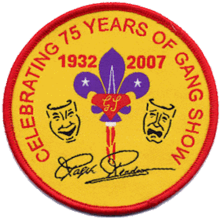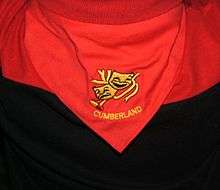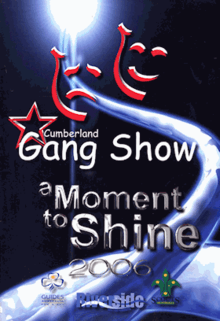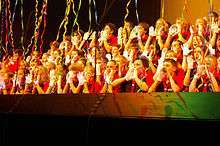Gang Show
A Gang Show is a theatrical performance by youth members of Scouts and Guides. Some Gang Shows have leaders of Scouts and Guides on stage too. Leaders, youth members and parents help behind the scenes. The aim is, through performance, to empower young people to make a positive contribution to society.
The production teams and cast (all volunteers) plan, write, compose, choreograph, build scenery and props, make costumes and rehearse for several months. A typical show requires 3 to 6 months of rehearsals. Every show does it differently, but every show has the same three priorities. 1. it is for the young people - 2. it is a public shop window on Scouting & Guiding, and therefore a great PR opportunity - 3. If they are lucky, they will at least break even.
Performance runs range from one day to two weeks, and tickets are available to the public. While a Gang Show is purely an amateur production, the costs can be similar to a professional production.
Gang Show format
The format is a revue or variety show; song, dance and short comedy sketches are the most common. The number of items varies between 12 and 25, some stand-alone, others a series of songs to a chosen theme or a running gag.
The format was created by Ralph Reader, the original producer, who wrote material including the signature tune, Crest of a Wave. Other "standards" Reader wrote include Strolling, Great Great Game, Gee, It's A Wonderful life, A Touch of Silver, Three Cheers, Show Time, Together, These are the Times and The Scout Hymn.
History

In 1931, Reader, a Rover Scout trying to make his mark in theatre in the USA and London, was asked to write a Scout-based variety show to raise money for a swimming pool at Downe Scout Camp (now a Scout Association National Activity Centre). Rehearsals began under Reader's direction on 25 May 1932, his 29th birthday).[1]
Initially the show did not have a title, but during a rehearsal break, Reader recalled, he asked a cast member if everyone was ready, to which the response was "Aye, aye Skip, the gang's all here". The first production, The Gang's All Here, ran between 30 October and 1 November 1932 at the Scala Theatre in central London.[1]
The show was not a sell-out but enough was raised to fund the swimming pool and the show was well received. Baden-Powell, the founder of scouting, persuaded Reader to produce another show in 1933. This was The Gang Comes Back and ran for a week.[1]
Reader continued to write and produce the London Gang Show. In 1934 the show became The Gang Show and Crest of a Wave was performed for the first time, becoming over the years the anthem.
In 1937 the London show became the first amateur production to have a Royal Command Performance (an honour repeated in 1957 and 1964). A feature film called The Gang Show, starring Ralph Reader and The Gang, premièred at the Lyceum Theatre, London in April the same year,[2] and in New York in December 1938.[3]
Organisation

When the Gang Show started in London in 1932, Reader organised the cast as a Scout Troop; an arrangement which persists only in a few shows now. Members of the first troop wanted an identifying feature, deciding on a red scarf or necker. The red scarf has become a worldwide symbol, and to distinguish shows, an insignia in gold thread (UK: the initials GS in Reader's handwriting shot through with the show's name - AUS: usually a design related to the masks of comedy and tragedy and incorporating the show's name) is embroidered into the point of the scarf. Ralph Reader was originally called "The Holborn Rover" and was with the 4th Holborn Group whose scarf was half red and half green. Reader chose to have the gang show scarf red to be part of the 4th Holborn.
Members of shows in the United Kingdom used to only be allowed to wear the scarlet scarf if they were nationally recognised, i.e. they came up to prescribed minimum standards of performance and production. It is now worn by almost all Gang Shows, but shows still need to apply for National Recognition every 5 years in order to maintain standards.
In 1972, Reader founded the London Gang Show Fellowship so current and former members of the London show could keep in touch. Membership later expanded to anyone interested in Gang Show.
Gang Shows around the world

Since the first in London, productions have been organised around the world,[4] Ireland,[5] Australia,[6] New Zealand[7] and Canada.[8] While individual in character, they share the ethos of Reader's concept and have common elements, often including a finale performance of Crest of a Wave.
In 1958 Reader went to Chicago to produce and direct the first Gang Show in America. He returned to Chicago next year to guide the second. Reader first went to Chicago in 1920 as a teenager and began his stage career there.[9]
The Glasgow Gang Show has, with few exceptions, run every year since April 1936.[10] Peterborough Gang Show started in November 1937 and apart from the war years has run ever since.[11] Harpenden Gang Show has performed every year since 1949.[12]
Signature tunes

On the Crest of a Wave has become the signature tune throughout the world and is usually performed at the end. It may be sung as just the chorus (traditionally twice, the first time with gusto, the second part-quiet and staccato, part with gusto once more) but there are also two verses.
A Touch of Silver (sometimes referred to as "Silver on the Scarlet"), written by Reader and Brisbane Gang Show producer Hugh "Kirra" McKee, is the signature tune of the Brisbane Gang Show and may be sung by any show that has performed for at least 25 seasons.
See also
References
- 1 2 3 Ralph Reader tells the history of the Gang Show
- ↑ The Lyceum Theatre and the Melvilles
- ↑ IMDb: The Gang Show (1938)
- ↑ List of UK Gang Shows
- ↑ National Star Scout Show
- ↑ Australian Gang Shows
- ↑ Gang Shows in New Zealand
- ↑ There are a lot of good scouts. More than 200 boys of all ages are involved in the second Mississaug...
- ↑ Chicago Council's 1959 Gang Show souvenir program.
- ↑ http://www.clydescouts.org.uk/spage-events_info-glasgow_gang_show.html Glasgow Gang Show
- ↑ http://www.peterboroughgangshow.com/gangshowspast.html Peterborough Gang Show
- ↑ http://www.hwgangshow.org.uk Harpenden Gang Show/
- Reader, Ralph This is The Gang Show, C. Arthur Pearson Ltd [London], 1957
- Reader, Ralph Ralph Reader Remembers, Bailey Brothers and Swinfen [London], 1975
External links
Scouting: Events: Gang Shows at DMOZ World Wide Forum
Global Gangshow
History